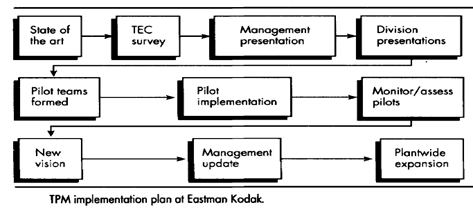SKEDSOFT
Introduction:
Maintenance, similarly to a large number of other activities, has been conducted in an ad-hoc manner in most manufacturing organisations. Total Quality Management is aimed at satisfying customer requirements. Implementation of TPM is approached differently by manufacturing organisations.
Example A: One of Eastman Kodak’s subsidiaries has implemented TPM successfully using the team approach. Tennessee Eastman Company (TEC) has defined TPM as follows:
A partnership between the maintenance and production organisations to improve product quality, reduce waste, reduce manufacturing cost, increase equipment availability, and improve TEC‘s state of maintenance. This partnership emphasizes the involvement of all employees in maintaining facilities and equipment.
Total Preventative Maintenance at TEC is centred round five main objectives which are geared towards bringing together maintenance personnel and operators, broadening their skills and encouraging them to support one another. The five objectives include the following:
1 Utilisation of operators to perform specified routine maintenance tasks on their equipment;
2 Utilisation of operators to assist mechanics in the repair of equipment when it is down;
3 Utilisation of mechanics to assist operators in the shutdown and startup of equipment;
4 Utilisation of lower skilled personnel to perform routine jobs not requiring skilled craftsmen;
5 Utilisation of computerized technology to enable operators to calibrate selected instruments.
Implementation of the TPM:
Study existing culture
-
Understand how existing control processes operate;

- Choose a management champion;
- Get the right people on board by making sure they are committed;
- Utilize their input/influence to design and sell the TPM plan.
Designing to change the culture
- Get people to change from a way of thinking based on ‘that’s not my job’ to a new way based on ‘this is what I can do to help’.
Building commitment
- Everyone who is involved in TPM has to get firsthand information on the nature
- Use milestones in building commitment, such as
- All personnel trained to perform TPM tasks
- Achieving cost reduction goals
- TPM expansion goals (new tasks undertaken)
- TPM task performance goals (total task count)
- Equipment uptime;
- Recognition for achievement of milestones. of the change, how the change is to be implemented and to what extent;
The team approach
- Conscious effort should be made to involve all levels of the organisation
Opportunity audit
- An opportunity audit needs to be conducted to provide additional insight into
- Start small, ensure success and build on strengths areas of greatest potential;
Anticipating concerns/ resistance
- A conscious effort has to be made to deal with concerns which may arise with positive responses.
Monitoring receptivity
- Informal feedbacks: use grapevine to gauge general receptivity;
- Formal surveys: to obtain input directly from everyone involved in the TPM implementation programme.